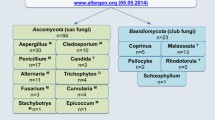Abstract
The majority of Aspergillus-induced infections in man are caused by the pathogenic fungus A. fumigatus, which secretes biologically and immunologically active glycosylated and nonglycosylated proteins. The complexity in the antigenic structure of A. fumigatus and the varying host immune responses lead toa widespectrum of clinical conditionssuch as allergic bronchopulmonary aspergillosis (ABPA), aspergilloma, and invasive aspergillosis. It is reported that 15–20% of allergic asthmatics suffer from Aspergillus-induced allergies. The incidence of opportunistic infections, including Aspergillus infections, has risen because of the increase in the incidence of HIV and tuberculosis. Allergic bronchopulmonary aspergillosis is an immunologically significant clinical form where type land type III hypersensitivity reactions are involved in pathogen esis. High levels of specific IgE and IgG antibodies in these patients are of diagnostic value. Molecular characterization of certain immunodominant all ergens and antigens of A. fumigatus revealed the presence of complex carbohydrate moieties, heat-shock proteins, enzyme activities such as elastase, protease, catalase, dismutase, and cytotoxic ribonuclease. A Con A binding allergen/antigen (45k Da) and Con Anonbinding allergen/antigen (18 kDa, Asp fI) have a multifunctional nature. The multifunctional nature of these antigens may play an important role in the pathogenesis of the disease. Significant amounts of a major allergen/antigen of molecular weight 18 kD a is excreted in large amounts through the urine of patients with invasive aspergillosis. Studies on the structure—function relationship of the 18-kDa allergen/antigen revealed the involvement of tryptophan residues in binding with monoclonal antibodies (MAbs). Also, the histidine residues and cysteine disulfide, bonds of the 18-kDa allergen are involved in its catalytic activity. The high load of multifunctional antigens in the serum of patients for prolonged periods, the presence of high levels of specific antibodies, and the absence of protective antibodies in ABPA patients have necessitated studies on the functional properties, of the antibodies. The present study shows significant immunoreactivity of antibodies in patients of ABPA to fibronectin and collagen Analysis of IgG antibodies from the patients of ABPA showed the presence of DNA-cleaving activity. These observations offer a new line of thinking in understanding the mechanism of pathogenesis of Aspergillus-induced clinical manifestations, and may lead to novel approaches to intervention in the inflammation and infection caused by fungal pathogens.
Similar content being viewed by others
References
Kurup, V. P. and Kumar, A. (1991), Clin. Microbiol. Rev. 4, 439–456.
Tomee, J. F. C., Kauffman, H. F., Klimp, A. H., Monmchyde, J. G. R., Koeter, G. H., and Dubois, A. E. J. (1994), J. Allergy Clin. Immunol. 93, 768–778.
Kolattukudy, P. E., Lee, J. D., Rogers, L. M., Zimmerman, P., Ceselski, S., Fox, B., Stein, B., and Copelan, E. A. (1993), Infect. Immunol. 6, 2357–2368.
Markaryan, A., Morozova, I., Yu, H., and Kolattukudy, P. E. (1994), Infect. Immun. 62, 2149–2157.
Eichner, R. D., Salami, M. A. L., Wood, P. R., and Mullbacher, A. (1986), Int. J. Immunopharmacol. 8, 789–797.
Robertson, M. D., Seaton, A., Milne, L. J. R., and Raeburn, J. A. (1987), Thorax 42, 466–472.
Slavin, R. G., Fischer, V. W., Levine, E. A., Tsai, C. C., and Winsenberger, I. (1978), Int. Arch. Allergy Appl. Immunol. 56, 325–343.
Murali, P. S., Dal, G., Kumar, A., Fink, J. N., and Kurup, V. P. (1992), Infect. Immun. 60, 1952–1956.
Abbas, A. K., Lichtman, A. H., and Pober, J. S. (1991), Cell. Mol. Immunol. WB Saunders Co., Philadelphia, PA.
Kumar, A., Reddy, L. V., and Sochanik, A. (1993), J. Allergy Clin. Immunol. 91, 1024–1029.
Beauvais, A., Monod, M., Debeaupuis, J. P., Diaquin, M., Kobayashi, H., and Latge, J. P. (1997), J. Biol. Chem. 272, 6238–6244.
Paul, S. (1996), Isr. J. Chem. 36, 207–214.
Gololobov, G. V., Chernova, E. A., Schourov, D. V., Smirnov, I. V., Kudelina, I. A., and Gabibov, A. G. (1995), Proc. Nat. Acad. of Sci. USA 92, 254–257.
Madan, T., Arora, N., and Sarma, P. U. (1997), Mol. Cell Biochem. 175, 21–27.
Banerjee, B., Madan, T., Sharma, G. L., Prasad, H. K., Nath, I., and Sarma, P. U. (1995), Serodiag. Immunotherap. Infect. Dis. 7, 147–152.
Banerjee, B., Chetty, A., Joshi, A. P., and Sarma, P. U. (1990), Asian Proc. J. Allergy Immunol. 18, 13–18.
Towbin, H., Stachalin, T., and Gordon, J. (1979), Proc. Nat. Acad. Sci. USA 76, 4350–4354.
Heusen, C. and Dowdle, B. E. (1980), Anal. Biochem. 102, 196–202.
Harlow, E. and Lane, D., eds. (1988), Antibodies: A Laboratory Manual, CSH Publications, New York.
Arruda, L. K., Platts-Mills, T. A. E., Fox, J. W., and Chapman, M. D. (1992), J. Exp. Med. 172, 1529–1532.
Arruda, L. K., Mann, B. J., and Chapman, M. D. (1992), J. Immunol. 149, 3354–3359.
Latge, J. P., Moutaouakil, M., Debeaupuis, J. P., Bouchara, J. P., Haynes, K., and Prevost, M. C. (1991), Infect. Immun. 59, 2586–2594.
Madan, T., Arora, N., and Sarma, P. U. (1997), Mol. Cell. Biochem. 167, 89–97.
Lamy, B., Moutaoukil, M., Latge, J. P., and Davies, J. (1991), J. Mol. Microbiol. 5, 1811–1815.
Madan, T., Banerjee, B., Bhatnagar, P. K., Shah, A., and Serma, P. U. (1997), Mol. Cell. Biochem. 166, 111–116.
Woolley, D. W. (1952), A Study of Antimetabolites., Wiley, New York.
Author information
Authors and Affiliations
Corresponding author
Rights and permissions
About this article
Cite this article
Purkayastha, S., Madan, T., Shah, A. et al. Multifunctional antigens of A. fumigatus and specific antibodies. Appl Biochem Biotechnol 83, 271–286 (2000). https://doi.org/10.1385/ABAB:83:1-3:271
Issue Date:
DOI: https://doi.org/10.1385/ABAB:83:1-3:271




